traction control CHEVROLET ASTRO 1996 Owners Manual
[x] Cancel search | Manufacturer: CHEVROLET, Model Year: 1996, Model line: ASTRO, Model: CHEVROLET ASTRO 1996Pages: 372, PDF Size: 21.51 MB
Page 92 of 372
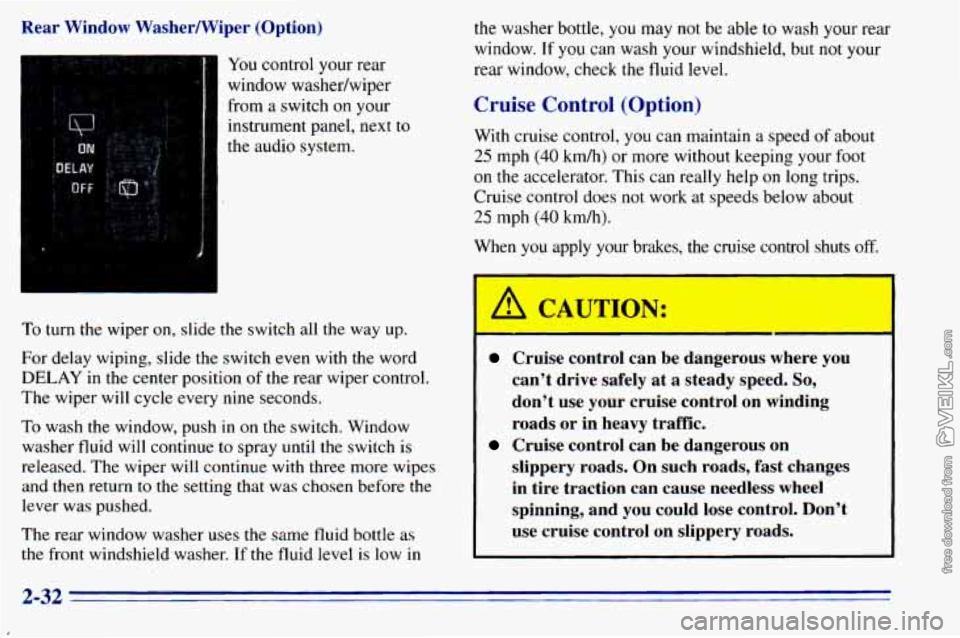
Rear Window Washermiper (Option) from
a switch on your
instrument panel, next to
the audio system.
To turn the wiper on, slide the switch all the way up.
For delay wiping, slide the switch even with
the word
DELAY in the center position of the rear wiper control.
The wiper will cycle every nine seconds.
To wash the window, push in on the switch. Window
washer fluid will continue
to spray until the switch is
released. The wiper will continue with three more wipes
and then return
to the setting that was chosen before the
lever was pushed.
The rear window washer uses the same fluid bottle as
the front windshield washer.
If the fluid level is low in
the washer bottle, you may not be able to wash your rear
window.
If you can wash your windshield, but not your
rear window, check
the fluid level.
Cruise Control (Option)
With cruise control, you can maintain a speed of about
25 mph (40 kmh) or more without keeping your foot
on the accelerator. This can really help on long trips.
Cruise control does not work at speeds below about
25 mph (40 km/h).
When you apply
y sakes, the *
A CAUTION:
#e con 1 sh i off.
Cruise control can be dal-,-- JUS wher - JOU
can’t drive safely at a steady speed. So,
don’t use your cruise control on winding
roads or in heavy traffic.
slippery roads. On such roads, fast changes
in tire traction can cause needless wheel
spinning, and you could lose control. Don’t
use cruise control on slippery roads.
Cruise control can be dangerous on
2-32
Page 162 of 372
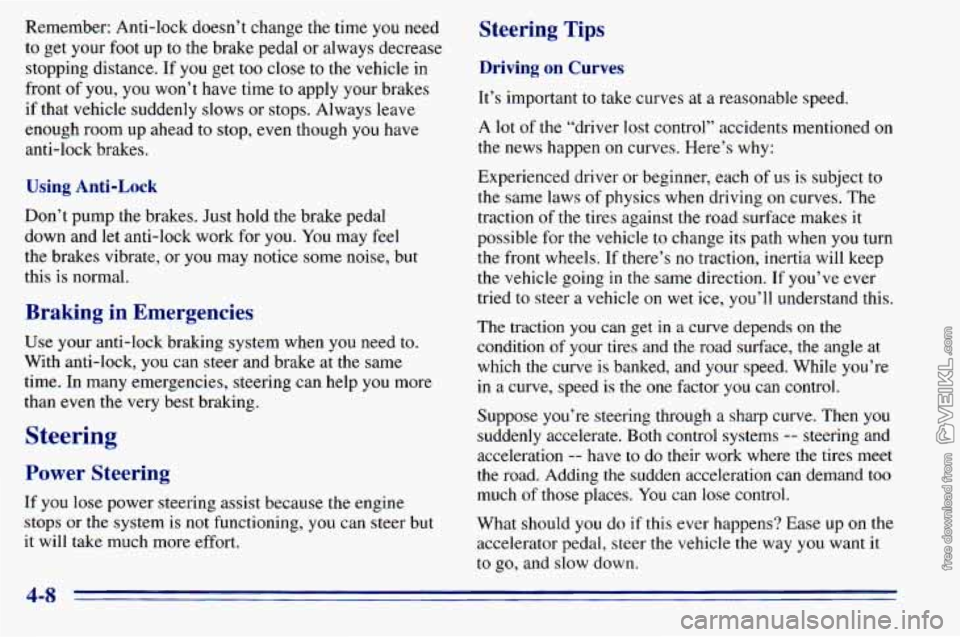
Remember: Anti-lock doesn’t change the time you need
to get your foot up
to the brake pedal or always decrease
stopping distance. If you get too close
to the vehicle in
front
of you, you won’t have time to apply your brakes
if that vehicle suddenly slows or stops. Always leave
enough room up ahead
to stop, even though you have
anti-lock brakes.
Using Anti-Lock
Don’t pump the brakes. Just hold the brake pedal
down and let anti-lock work for you. You may feel
the brakes vibrate, or you
may notice some noise, but
this
is normal.
Braking in Emergencies
Use your anti-lock braking system when you need to.
With anti-lock, you can steer and brake at the same
time. In many emergencies, steering can help you more
than even the very best braking.
Steering
Power Steering
If you lose power steering assist because the engine
stops
or the system is not functioning, you can steer but
it will take much more effort,
Steering Tips
Driving on Curves
It’s important to take curves at a reasonable speed.
A lot of the “driver lost control’’ accidents mentioned on
the news happen on curves. Here’s why:
Experienced driver or beginner, each of us is subject to
the same laws of physics when driving
on curves. The
traction
of the tires against the road surface makes it
possible for the vehicle to change its path when
you turn
the front wheels.
If there’s no traction, inertia will keep
the vehicle going
in the same direction. If you’ve ever
tried to steer a vehicle
on wet ice, you’ll understand this.
The traction
you can get in a curve depends on the
condition of your tires and the road surface, the angle
at
which the curve is banked, and your speed. While you’re
in a curve, speed is the one factor
you can control.
Suppose you’re steering through a sharp curve. Then
you
suddenly accelerate. Both control systems -- steering and
acceleration
-- have to do their work where the tires meet
the road. Adding the sudden acceleration can demand too
much
of those places. You can lose control.
What should you do
if this ever happens? Ease up on the
accelerator
pedal, steer the vehicle the way you want it
to
go, and slow down.
4-8
Page 166 of 372
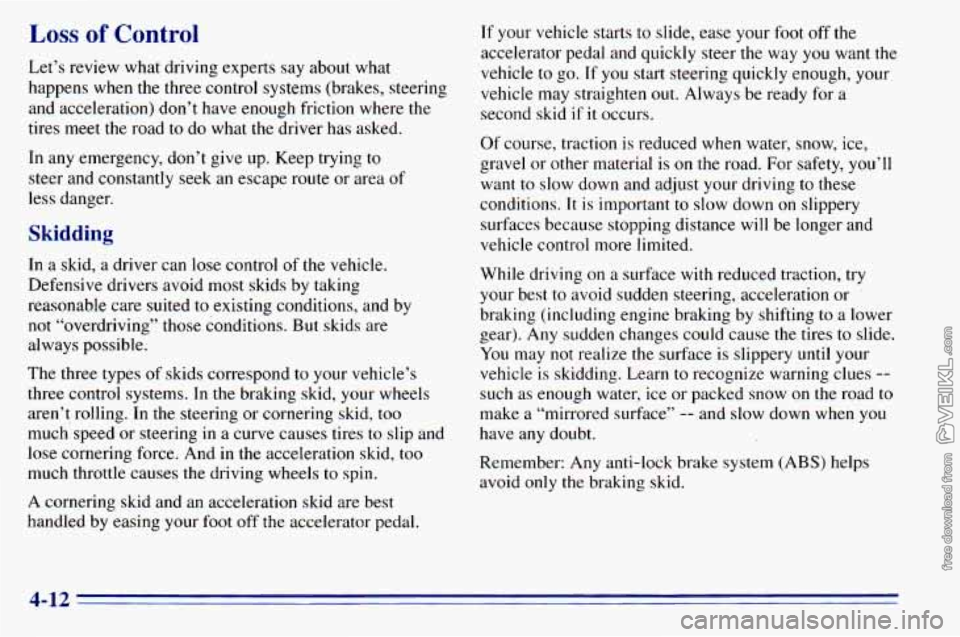
Loss of Control
Let’s review what driving experts say about what
happens when the three control systems (brakes, steering
and acceleration) don’t have enough friction where the
tires meet the road
to do what the driver has asked.
In
any emergency, don’t give up. Keep trying to
steer and constantly seek an escape route or area of
less danger.
Skidding
In a skid, a driver can lose control of the vehicle.
Defensive drivers avoid most skids by taking
reasonable care suited to existing conditions, and by
not “overdriving” those conditions. But skids are
always possible.
The three types
of skids correspond to your vehicle’s
three control systems. In the braking skid, your wheels
aren’t rolling. In
the steering or cornering skid, too
muchspeed or steering
in a curve causes tires to slip and
lose cornering force. And in the acceleration skid, too
much throttle causes the driving wheels
to spin.
A cornering skid and an acceleration skid are best
handled by easing your foot off the accelerator pedal.
If your vehicle starts to slide, ease your foot off the
accelerator pedal and quickly steer the way
you want the
vehicle
to go. If you start steering quickly enough, your
vehicle may straighten out. Always be ready for a
second skid
if it occurs.
Of course, traction is reduced when water, snow, ice,
gravel or other material is on the road. For safety,
you’ll
want to slow down and adjust your driving to these
conditions. It is important to slow down
on slippery
surfaces because stopping distance will be longer and
vehicle control more limited.
While driving on a surface with reduced traction, try
your best to avoid sudden steering, acceleration or
braking (including engine braking by shifting
to a lower
gear).
Any sudden changes could cause the tires to slide.
You may not realize the surface is slippery until your
vehicle is skidding. Learn to recognize warning clues
--
such as enough water, ice or packed snow on the road to
make a “mirrored surface”
-- and slow down when you
have any doubt.
Remember: Any anti-lock brake system (ABS) helps
avoid only
the braking skid.
4-12
Page 276 of 372
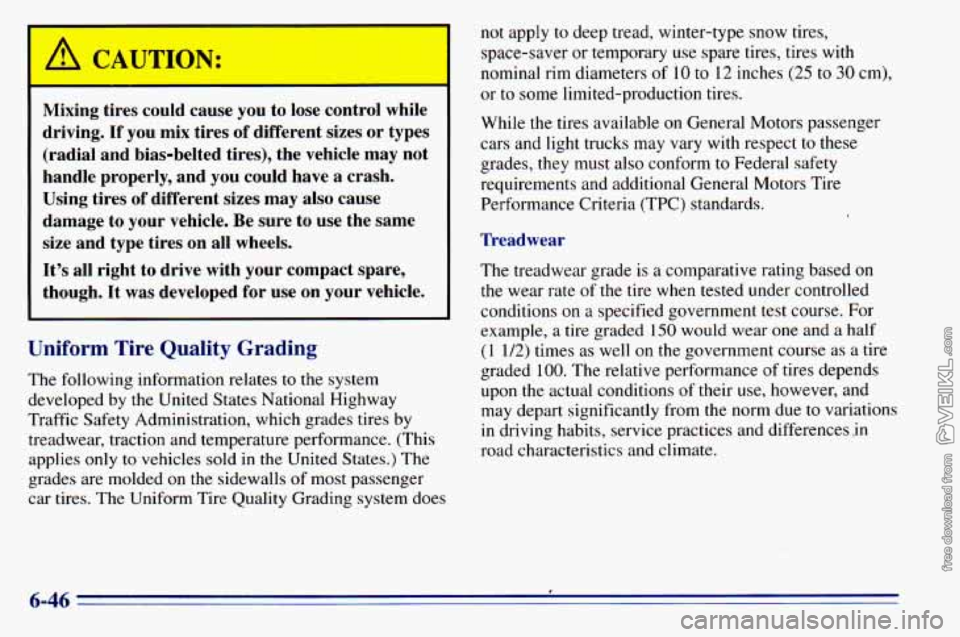
I
ng tires could cause you to lose control while
driving. If you mix tires of different sizes or types
(radial and bias-belted tires), the vehicle may not
handle properly, and you could have
a crash.
Using tires of different sizes may also cause
damage to your vehicle. Be sure to use the same
size and type tires on all wheels.
It’s all right to drive with your compact spare,
though. It was developed
for use on your vehicle.
Uniform Tire Quality Grading
The following information relates to the system
developed by
the United States National Highway
Traffic Safety Administration, which grades tires by
treadwear, traction and temperature performance. (This
applies
only to vehicles sold in the United States.) The
grades are molded on the sidewalls of most passenger
car tires. The Uniform Tire Quality Grading system does not apply to
deep tread, winter-type snow tires,
space-saver or temporary use spare tires, tires with
nominal rim diameters
of 10 to 12 inches (25 to 30 cm),
or to some limited-production tires.
While
the tires available on General Motors passenger
cars and light trucks may vary with respect to
these
grades, they must also conform to Federal safety
requirements and additional General Motors Tire
Performance Criteria (TPC) standards.
Treadwear
The treadwear grade is a comparative rating based on
the wear rate of the tire when tested under controlled
conditions on
a specified government test course. For
example, a tire graded
150 would wear one and a half
(1 1/2) times as well on the government course as a tire
graded
100. The relative performance of tires depends
upon the actual conditions of their use, however, and may depart significantly from the norm due to variations
in driving habits, service practices and differences Jn
road characteristics and climate.
6-46
d
Page 277 of 372
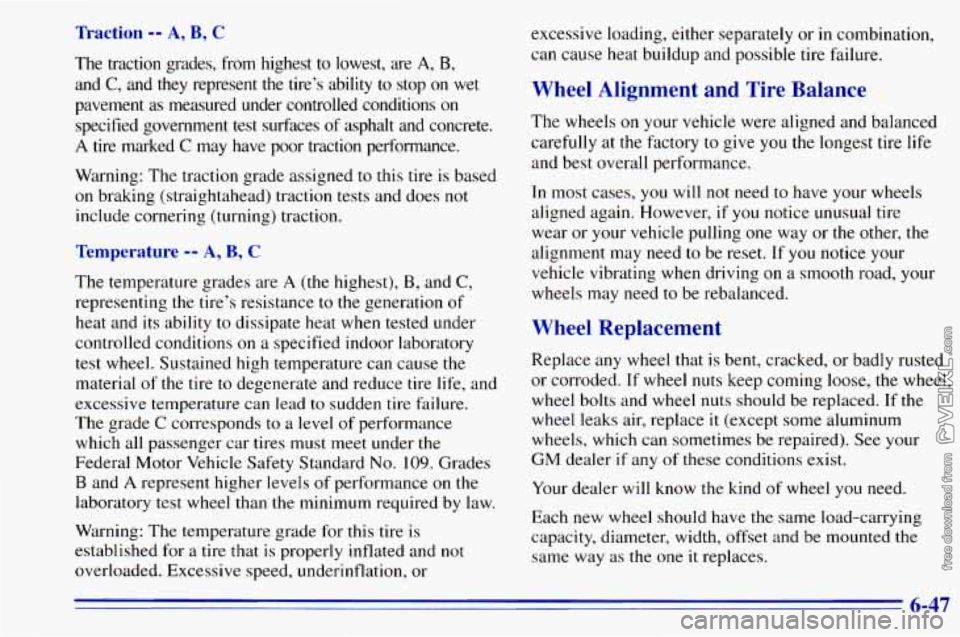
Traction -- A, B, C
The traction grades, from highest to lowest, are A, B,
and C, and they represent the tire’s ability to stop on wet
pavement as measured under controlled conditions on specified government test surfaces of asphalt and concrete.
A tire marked C may have poor traction performance.
Warning: The traction grade assigned to this tire is based
on braking (straightahead) traction tests and does not
include cornering (turning) traction.
Temperature -- A, B, C
The temperature grades are A (the highest), B, and C,
representing
the tire’s resistance to the generation of
heat and its ability
to dissipate heat when tested under
controlled conditions
on a specified indoor laboratory
test wheel. Sustained high temperature can cause
the
material of the tire to degenerate and reduce tire life, and
excessive temperature can lead
to sudden tire failure.
The grade
C corresponds to a level of performance
which all passenger car tires must meet under the
Federal Motor Vehicle Safety Standard
No. 109. Grades
B and A represent higher levels of performance on the
laboratory test wheel than the minimum required by law.
Warning: The temperature grade for this tire is
established for a tire that
is properly inflated and not
overloaded. Excessive speed, underinflation, or excessive loading, either
separately or in combination.
can cause heat buildup and possible tire failure.
Wheel Alignment and Tire Balance
The wheels on your vehicle were aligned and balanced
carefully at the factory
to give you the longest tire life
and best overall performance.
In most cases, you will
not need to have your wheels
aligned again. However, if
you notice unusual tire
wear or your vehicle pulling one way or the other, the
alignment may need to be reset.
If you notice your
vehicle vibrating when driving
on a smooth road, your
wheels may need to be rebalanced.
Wheel Replacement
Replace any wheel that is bent, cracked, or badly rusted
or corroded. If wheel nuts keep coming loose,
the wheel,
wheel bolts and wheel
nuts should be replaced. If the
wheel leaks air, replace
it (except some aluminum
wheels, which can sometimes be repaired). See your
GM dealer if any of these conditions exist.
Your dealer will know
the kind of wheel you need.
Each new wheel should have the same load-carrying
capacity, diameter, width, offset and be mounted the
same way as
the one it replaces.
6-47
Page 369 of 372
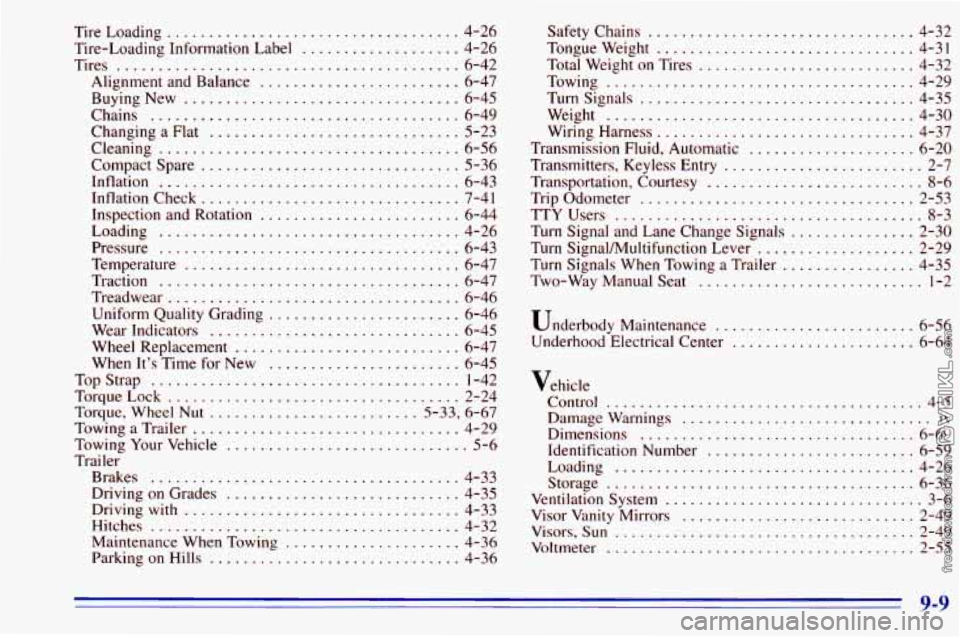
Tire Loading ............................... 4-26
Alignment and Balance
........................ 6-47
Buying New
................................. 6-45
Chains
..................................... 6-49
Changing a Flat
.............................. 5-23
Cleaning
.................................... 6-56
Compact Spare
............................... 5-36
Inflation
.................................... 6-43
Inflation Check
............................... 7-41
Inspection and Rotation
........................ 6-44
Loading
.................................... 4-26
Pressure
.................................... 6-43
Temperature
................................. 6-47
Traction
.................................... 6-47
Treadwear
................................... 6-46
Uniform Quality Grading
....................... 6-46
Wear Indicators
.............................. 6-45
When It's Time for New
....................... 6-45
TopStrap
..................................... 1-42
TorqueLock
................................... 2-24
Tire-Loading
Information Label
................... 4-26
Tires
......................................... 6-42
Wheel Replacement
........................... 6-47
Torque. Wheel
Nut ......................... 5-33. 6-67
Towing
a Trailer ................................ 4-29
Towing Your Vehicle
............................. 5-6
Driving on Grades ............................ 4-35
Trailer
Brakes
..................................... 4-33
Drivingwith
................................. 4-33
Hitches
..................................... 4-32
Maintenance When Towing
..................... 4-36
Parking
on Hills .............................. 4-36 Safety
Chains
................................ 4-32
Tongueweight
............................... 4-31
Total Weight on Tires
.......................... 4-32
Towing
..................................... 4-29
Turnsignals
................................. 4-35
Weight
..................................... 4-30
Wiring Harness
............................... 4-37
Transmission Fluid. Automatic
.................... 6-20
Transmitters. Keyless Entry
........................ 2-7
Transportation. Courtesy
.......................... 8-6
Trip Odometer
................................. 2-53
TTY Users
..................................... 8-3
Turn Signal and Lane Change Signals
............... 2-30
Turn Signal/Multifunction Lever
................... 2-29
Turn Signals When Towing
a Trailer ................ 4-35
Two-way Manual Seat
........................... 1-2
Underbody 'Maintenance ....... ........... 6-56
Underhood Electrical Center
...................... 6-64
Vehicle Control
...................................... 4-5
Damage Warnings
.............................. iv
Dimensions ................................. 6-69
Identification Number
......................... 6-59
Loading .................................... 4-26
Storage
..................................... 6-36
Ventilation System
............................... 3-6
Visor Vanity Mirrors
............................ 2-49
Visors. Sun
.................................... 2-49
Voltmeter
................................. 2-55
9-9